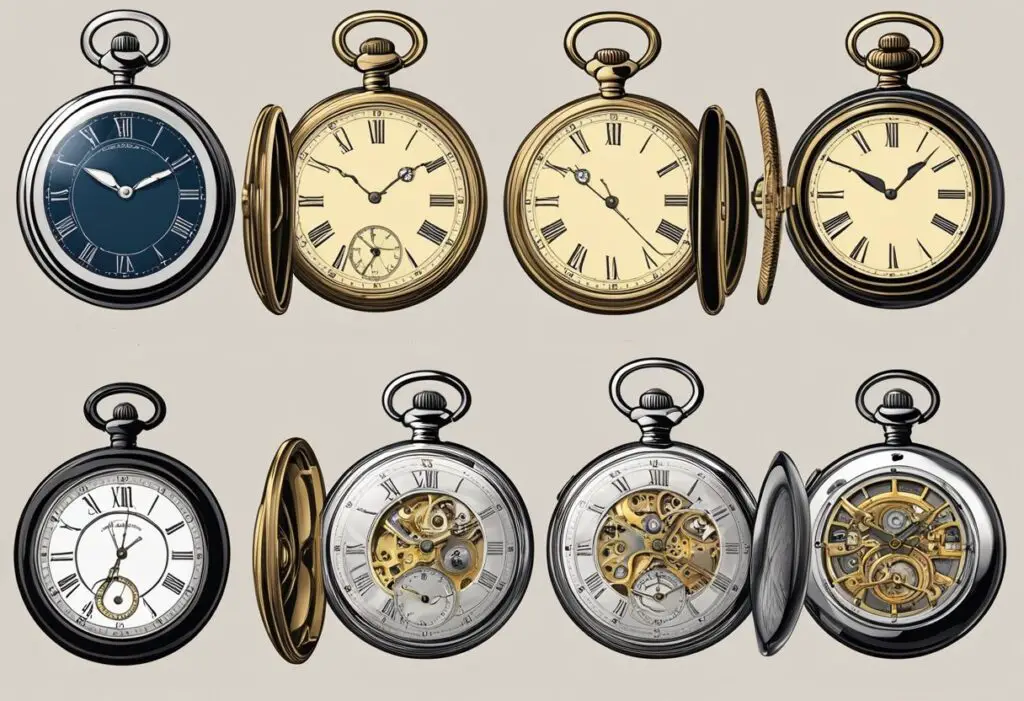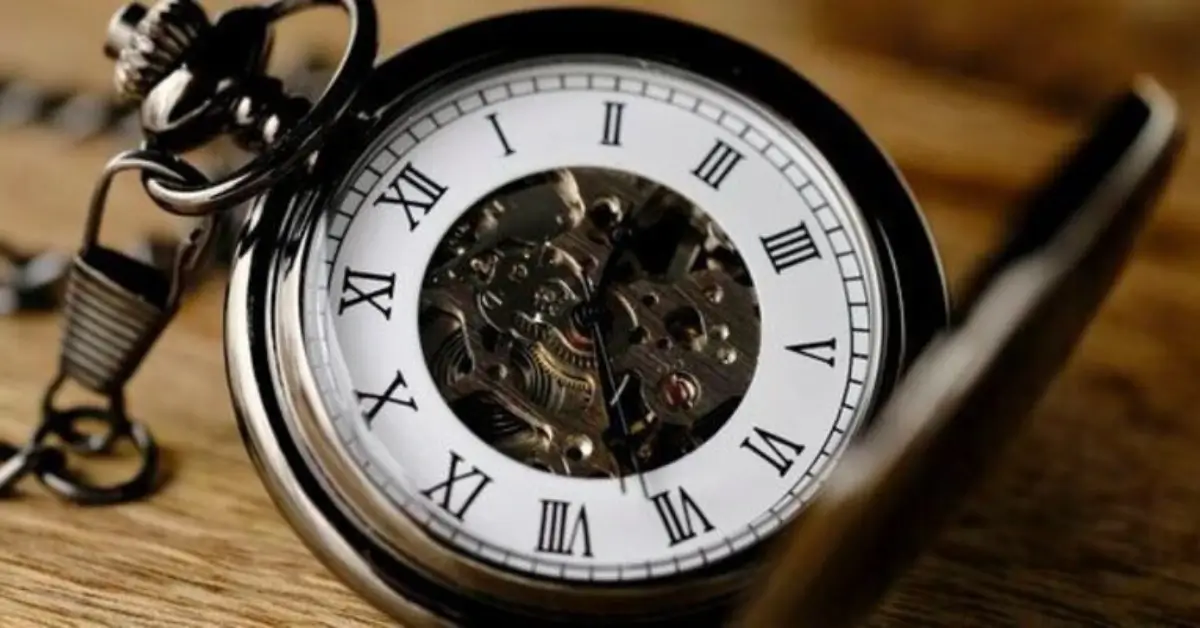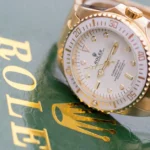Pocket watch manufacturers have long been an integral part of the horological industry. With their expertise in creating intricate timepieces, these craftsmen have shaped the evolution of watchmaking from the early days of European royalty to the present day.
We’ve seen a resurgence of interest in pocket watches in recent years, as people seek to combine timeless elegance with modern functionality. Today, pocket watch manufacturers, both established and emerging, continue to design and produce these unique timepieces for a growing community of enthusiasts around the world.
In this article, we will explore the fascinating world of pocket watch manufacturers and learn about the key players in this niche market. Whether you’re a collector, a fashion aficionado, or just someone who appreciates fine watchmaking, join us as we delve into the history, artistry, and innovation of these exceptional timekeepers.
History of Pocket Watch Manufacturers

As pocket watch Enthusiasts, we’ve always been fascinated by the history behind these classic timepieces. The journey of pocket watches began in the 16th century, with their invention attributed to a master locksmith from Nuremberg, Germany, named Peter Henlein.
Peter Henlein started manufacturing pocket watches around 1526, spreading the art of pocket watch-making throughout Europe. Early pocket watches were simplistic in design, with only an hour hand. The minute hand was introduced much later, in the late 17th century.
During the 16th century, pocket watches became more refined, with European craftsmen experimenting with various materials, shapes, and sizes. They were considered a luxury item and a symbol of wealth and social standing.
As advancements in technology and manufacturing techniques progressed, pocket watches evolved in functionality and aesthetics. By the 18th and 19th centuries, pocket watches were becoming more accessible to the general public.
Types and Styles

Vintage and Retro Styles
For those who appreciate a timeless design, vintage and retro pocket watches are the perfect choice. These watches often feature a classic open face watch case, allowing for a quick time check without having to open a cover. Some popular hand styles available in this range include the Fine Spade, Spade, and Whip designs.
Luxury Pocket Watches
Luxury pocket watch collections are designed for those who value elegance and sophistication. Brands such as Patek Philippe and Audemars Piguet offer exquisite pocket watches that can even become treasured family heirlooms. These high-end watches boast exceptional craftsmanship, intricate detailing, and premium materials like gold and platinum. Owning a luxury pocket watch is a statement of refinement and connoisseurship.
Steampunk Pocket Watches
Lastly, for fans of the steampunk aesthetic, the range of steampunk pocket watches is sure to impress. These watches blend modern technology with the design elements of Victorian-era machinery, featuring gears, cogs, and other industrial-inspired components. Many of these watches, such as the Stuhrling Original Men’s Pocket Watch, showcase a skeleton design that reveals the intricate inner workings of the timepiece.
Key Manufacturers
As pocket watch enthusiasts, we’ve come across many incredible timepieces crafted by various pocket watch manufacturers over the years. In this section, we’ll delve into some of the key American and European brands that have stood the test of time and continue to captivate collectors worldwide.
American Watch Companies
In the realm of American pocket watch manufacturing, companies like Waltham, Hamilton, and Elgin have left a lasting impact. The Waltham Watch Company was one of the first to produce high-quality pocket watches on a large scale, pioneering automated production techniques that revolutionized the industry. Waltham pocket watches are now sought-after collector’s items, prized for their historical significance and superb craftsmanship.
Hamilton Watch Company is another prominent American brand, known for its precision and innovative designs that catered to the growing needs of the railroad industry. Similarly, Elgin National Watch Company enjoyed enormous success during its heyday, producing a wide range of popular pocket watches that hold a special place in the hearts of collectors.
The Timex Corporation and Bulova are also notable American watchmakers, with roots traced back to the early 20th century. Although these companies are now focused more on wristwatches, their contributions to the pocket watch industry cannot be overlooked.
European Watch Brands
Europe is home to numerous prestigious pocket watch manufacturers, with Swiss brands holding a particularly esteemed reputation in the world of horology. Brands such as Patek Philippe, Audemars Piguet, and IWC Schaffhausen have been producing exceptional pocket watches for centuries, featuring intricate mechanical movements and exquisite designs that epitomize fine watchmaking.
Tissot, another esteemed Swiss manufacturer, has a rich history dating back to the mid-19th century. The company produced various pocket watches and even introduced innovative features, such as the first mass-produced pocket watch with dual time zones.
French brand Charles-Hubert is also worth mentioning, as it offers a diverse range of pocket watches that cater to different tastes, from vintage-inspired designs to contemporary quartz movements.
Lastly, we cannot forget Longines, a Swiss brand with a vast heritage, known for their elegant and high-quality pocket watches that have graced the pockets of many notable individuals throughout history.
Materials and Design Elements

As pocket watch enthusiasts, we strive to find timepieces with exceptional materials, design elements, and craftsmanship. In this section, we explore the use of gold and silver in watchmaking, the intricacy of skeleton watches, and the choice between Roman and Arabic numerals.
Gold and Silver Watches
Two of the most popular materials used by pocket watch manufacturers are gold and silver. Both precious metals have been highly regarded for their durability, elegance, and value. Gold pocket watches often come in various karats (14K, 18K, 24K), with 24K being the purest form. Silver pocket watches are often crafted from sterling silver or solid silver.
- Gold: Luxurious, resistant to tarnishing, and valuable
- Silver: Elegant, more affordable than gold, and conducts excellent thermal properties
Skeleton Watches
Skeleton watches showcase the intricate mechanics of a watch by revealing the gears and movements. This artistry and transparency provide a fascinating window into the inner workings of timepieces. Many collectors and enthusiasts are captivated by these detailed designs, making skeleton watches highly desirable among fans of horology.
Roman and Arabic Numerals
There are two common numeral styles found on the dials of pocket watches: Roman and Arabic numerals.
- Roman numerals: These classic, elegant symbols add a touch of sophistication to the watch and harken back to an earlier time in human history. Examples: XII, III, IX
- Arabic numerals: These numerals are much simpler in design, with a more modern and straightforward appearance. Examples: 12, 3, 9
Each style has its own distinctive charm, and the choice of numerals ultimately depends on the pocket watch manufacturer’s design philosophy and the personal taste of the buyer.
Mechanisms and Movements
As pocket watch enthusiasts, we understand the importance of the mechanisms and movements that power these timeless pieces. In this section, we’ll explore the different types of movements found in pocket watches: Mechanical Movements, Automatic Movements, and Quartz Movements.
Mechanical Movements
Mechanical movements are the traditional choice for most pocket watches. The driving force behind a mechanical movement is a tightly wound spring called the mainspring, which gradually unwinds and releases energy to move the watch’s gears and hands. These movements require regular winding, either manually or automatically, to maintain timekeeping. Mechanical movements are known for their intricate craftsmanship, and they have been a symbol of horological art for centuries.
Automatic Movements
Automatic movements, also known as self-winding or perpetual movements, are a type of mechanical movement that doesn’t require manual winding. Instead, they rely on a weighted rotor that rotates with the natural movement of the wearer’s wrist or the user’s daily activity. This rotation winds the mainspring, ensuring that the watch continues to run without intervention. Although automatic movements are more commonly associated with wristwatches, some pocket watch manufacturers have incorporated them into their designs as well.
Quartz Movements
Quartz movements, introduced in the 1960s, are a more modern alternative to mechanical movements. They use a battery and a small quartz crystal as the timekeeping element. The battery sends an electric current through the quartz, causing it to vibrate at a precise frequency. This vibration is translated into timekeeping by a series of electronic circuits and a stepper motor. Quartz movements are known for their accuracy, low maintenance, and affordability compared to mechanical counterparts. However, they may lack the charm and craftsmanship that draw collectors to mechanical and automatic pocket watches.
Care and Maintenance
As pocket watch enthusiasts, we understand the importance of properly caring for and maintaining your precious timepiece. In this section, we’ll provide you with some essential tips on how to keep your pocket watch in pristine condition.
Firstly, it’s important to keep your watch safe while you’re wearing it. Attach it securely with a chain to a buttonhole, belt loop, or your belt to prevent it from falling out of your pocket and to catch it if you accidentally drop it source.
Cleaning the outside of your pocket watch is essential for maintaining its appearance. We recommend using a soft microfiber cloth to gently wipe away any dirt or fingerprints, avoiding harsh cleaners or water, which could damage the surface and internal parts source. If your watch has an open face, be extra cautious and ensure that the dial faces inwards when carrying it in your pocket to protect the crystal from damage source.
Mechanical pocket watches require regular winding to keep them running accurately. Wind your watch daily, ideally at the same time each day, using slow and gentle turns of the winding crown. Over-winding can damage the movement, so stop winding as soon as you feel resistance. For quartz pocket watches, remember to replace the battery as soon as the watch starts losing time to prevent leakage and damage to the movement source.
Finally, it’s a good idea to have your pocket watch serviced by a professional watchmaker every few years. Regular servicing helps maintain the accuracy and longevity of your timepiece, ensuring that any worn or damaged parts are replaced, and the movement is cleaned and lubricated source.
How to Wear a Pocket Watch
We often get questions about the proper way to wear a pocket watch. Worry not, we’re here to help you look stylish and elegant with this timeless accessory.
The most classic way to wear a pocket watch is with a waistcoat. This is not only the most traditional approach, but also still quite stylish. When wearing a pocket watch with a waistcoat, you have two pocket watch chain styles to choose from: The Single Albert or the Double Albert. These chains make it easier to attach your pocket watch and give your attire an extra touch of sophistication.
However, it doesn’t mean that pocket watches can only be worn with waistcoats. You can also wear a pocket watch with trousers. For this, simply secure the pocket watch chain to a belt loop using a T-bar and place the watch in your pocket. If you’d like, you can even attach the chain to your lapel instead for a more unique look.
Regardless of the style you choose, make sure to properly attach your pocket watch using a T-bar or watch chain. The T-bar is more suitable for waistcoats and can be fastened to a buttonhole, while the watch chain is more appropriate for trousers or belts.
Remember to consider the attire you’re wearing when choosing the type of pocket watch and chain. Formalwear allows for more complex chain styles and ornate pocket watches, whereas casual wear is better suited for simple, modern chains and watches.
By following these guidelines, you’ll be able to wear a pocket watch with confidence. Happy accessorizing!
Buying Tips for Pocket Watches
We understand how important it is to find the perfect timepiece. In this section, we’ll provide you with some helpful buying tips to ensure you find the best pocket watch to suit your style and budget.
Firstly, consider your preferred price range, as pocket watches can range from affordable options to high-end investment pieces. Keep in mind that a higher price doesn’t always guarantee better quality. Take the time to research different manufacturers and compare their offerings before making a purchase.
When looking at various pocket watches, pay attention to the movement type. Mechanical pocket watches typically require manual winding, while battery-powered options might be more convenient for everyday use. Determine which type suits your preferences, and remember to consider the inner movements of the watch as well.
An important factor to consider when purchasing a pocket watch is its design. With many styles available, choose a watch that complements your personal taste and fits well within your watch collection. Also, think about whether you prefer an open or closed face watch, as this can impact the overall aesthetics of the timepiece.
In addition, don’t shy away from joining mailing lists or subscribing to newsletters from reputable pocket watch manufacturers. This can provide you with exclusive access to sales and promotional offers, potentially saving you money on your next pocket watch purchase.
Lastly, remember that purchasing a pocket watch is an investment, not only in the timepiece itself but also in the future of your watch collection. By taking the time to carefully consider your options and following these buying tips, you’ll be well on your way to acquiring a timeless and stylish pocket watch.
FAQ-Pocket Watch Manufacturers
What are some affordable pocket watch brands?
There are several pocket watch brands that offer quality timepieces at affordable prices. Brands like Stührling, Gotham, and Charles-Hubert are known for their reasonably priced pocket watches, which can be found under $100.
Which luxury brands offer pocket watches?
Luxury brands like Patek Philippe, Audemars Piguet, and Vacheron Constantin have a long history of crafting exquisite pocket watches. These high-end brands are renowned for their craftsmanship, precision, and the use of premium materials, making their pocket watches a treasured addition to any collection.
How can I identify a pocket watch maker’s mark?
Identifying a pocket watch maker’s mark typically involves examining the watch’s movement or case. Pocket watch manufacturers usually leave their mark or logo engraved on these parts. To identify the mark, you might need a magnifying glass or loupe to see the details clearly.
If you liked this blog post about the topic: Pocket Watch Manufacturers, don’t forget to leave us a comment down below to tell us about your experience with it.






Thanks for sharing. I read many of your blog posts, cool, your blog is very good.
Thank you for your sharing. I am worried that I lack creative ideas. It is your article that makes me full of hope. Thank you. But, I have a question, can you help me?
Your point of view caught my eye and was very interesting. Thanks. I have a question for you.